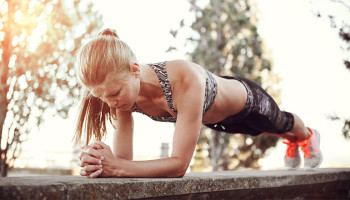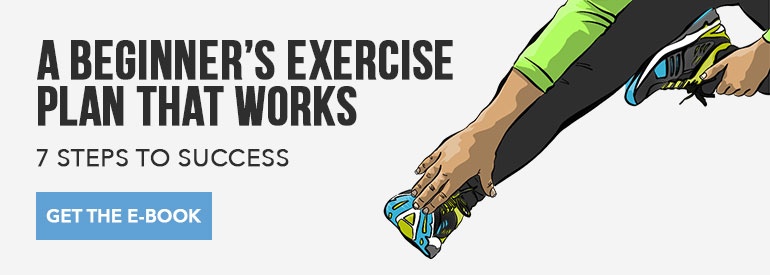 Reading Time: 6 minutes
Reading Time: 6 minutesAfter running a gym for a while, I noticed that many women who have had children can’t do sit-ups anymore. Now there’s a strange gap in evolutionary pressure! I won’t dispute that we were “born to run,” but I’m going to go out on a limb and suggest we were not “born to do sit-ups.”
Which isn’t really a problem, since you don’t need to do sit-ups to get great abs.
There are many superior options that will shred your abs without chafing your butt. And they are also easily scaled for all fitness levels. Here are three of my favorite uncommon ab workouts that will take your fitness to another level.
1. The Ag Walk
The ag walk was introduced to me by famed gymnastics coach Christopher Sommer. Coach Sommer has his athletes assume a hand plank position. Then they put their toes into furniture sliders and race each other down a 26-meter tumble track, still in a hand plank position, dragging their toes behind them. One lap is unbelievably difficult. Twelve laps will make you weep.
By the way, “ag” is short for agony, which is what you feel after doing these.
Why Do It
This is my all-time favorite ab workout because it makes you better at everything. A stable core in a hip-extended position is the key to generating massive force through your extremities. Without that foundation skill, you leak energy whenever you try to throw, jump, tackle, or lift.
The ag walk is great for practical core strength because you have to maintain ab and butt contraction while moving your limbs dynamically. It also makes you extremely hot and sweaty, if you’re into that sort of thing.
How to Start
For most folks, the ag walk is easy on the shoulders. You don’t have to extend your arms over your head or push or pull violently. Nevertheless, if your shoulders won’t allow a hand plank, you can’t do an ag walk.
Start with the basics. Get your hand plank down first. Once you can hold a hand plank for a minute or so try to ag walk for about thirty feet. Gradually up the distance until you can go about eighty feet without stopping.
Scaling Options
If you are working out on a carpet or AstroTurf, you can use furniture sliders or a Frisbee under your feet. On a wood surface, you can use a power wheel (as shown in the video) or a rag or towel. On a rubber mat, you can put your feet on an ultra-high-molecular-weight skid. Many gyms now equip their sleds with UHMW skids that slide easily over a rubber surface. You can scrounge up UHMW skids online or just take them off a spare sled.
2. The Badonkadonk
For some reason you don’t see this movement very much. I learned it a long time ago at a Brazilian jiu jitsu academy. We didn’t have a name for it. We just groaned when our coach made us do them. If you want to see a bunch of tough guys wilt, make them do sixty seconds of these bad boys.
Later when I started coaching, I programmed this element all the time and decided to call it the Badonkadonk, because, well, look at the video. For no reason that I can fathom, my female clients loved this movement. Go figure.
Why Do It
The Badonkadonk is awesome for people with neck or back problems. Because your back is planted on the floor, you can still scorch your abs, without whipping your neck through a ballistic movement. For sporty skill transference, the Badonkadonk is great because it trains you to lift and move your hips in a dynamic range of motion. This is the foundation of bridging, kicking, leaping, running, etc.
In contrast, the sit-up trains you to lift your head while your hips are immobilized, something you never see — except when somebody is doing sit-ups.
How to Start
In the video, you’ll see the first six or so reps are performed slowly and that is how you should start. Make sure to lift your hips completely off the ground and try to tap the ground on either side. Right butt cheek taps right, left butt cheek taps left, and so on. Remember to press your hands into the ground to stabilize your spine.
Once you have the movement down, try to pick up the pace for 15-second sets. A good aspirational goal is a flat-out sprint for two or three 60-second sets.
Scaling Options
If you have very tight hamstrings or lower back, you will want to start out with a bend in your knees. Instead of bouncing side to side, lift your hips straight up and down as you seek out your maximum comfortable range of motion. Slow it down and treat the movement as a lower body mobilizer.
3. The L-Sit
L-sits were once a staple of gymnastic conditioning, but nowadays everyone from CrossFitters to the Barstarzz crew have incorporated the L-sit into their regimens. The L-sit even made an appearance in the 2011 CrossFit Games with a 51-second hold taking top honors. I will freely confess that I detested the L-sit when Whole Life Challenge co-founder Andy Petranek made me do them at CrossFit LA, but over the years I have come to respect, if not enjoy this element.
Why Do It
Static holds like the L-sit give you the “other kind” of strength where you have to hold a weight in place. Speaking as someone who must daily hold (and not drop) a forty-pound toddler in all sorts of awkward positions, I can tell you that static strength is a very good thing. The L-sit also does wonders for hip flexor strength, which gives you more runway in squatting and jumping.
How to Start
The beauty of L-sits is that you can do them anywhere. Most people end up buying or making parallettes, and eventually the daring might even want to use rings. But starting out, you can do L-sits on a couple of telephone books or even the ground.
With L-sits and other static holds, the key is to accumulate volume with lots of short sets of very high quality. The quality of a set is determined by the intensity of the contraction. You must maintain a very strong contraction without loss of form.
For beginners, you can try 6 sets of 4 seconds for a total of 24 seconds. Then try 3 sets of 8 seconds, then 2 sets of 12 seconds and so on. A 40-second L-sit is within reach if you train consistently.
Scaling Options
If you can’t lift your legs into an L, then start with the chair sit. Just allow your knees to bend so it looks like you’re sitting in a chair. Also, if you lack full elbow extension, as I do, your shoulders overcompensate, which can make the L-sit inherently unstable. Know your limits and ease back on the volume.
Which of These Ab Workouts Is for You?
The best way to answer that question is to give each one a try. Be patient with yourself and commit to doing regular, even if short, sessions.
Don’t let a dislike or inability to do sit-ups stop you from building a strong and functional mid-section. Practice these ab workouts regularly and see how the right abdominal exercises can build far more than a six-pack.







